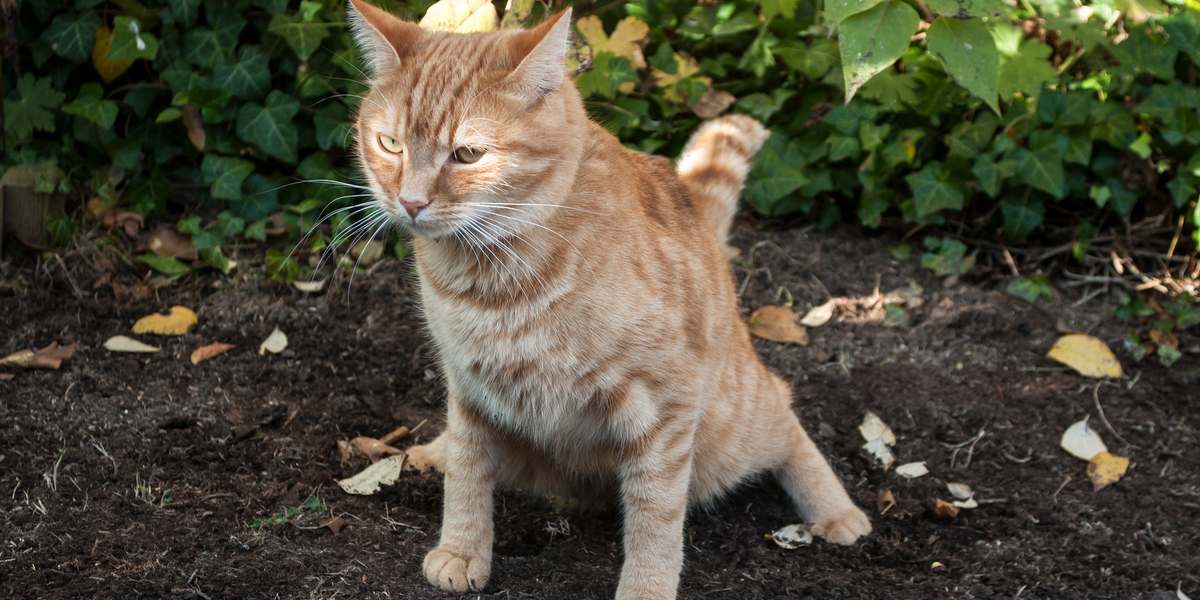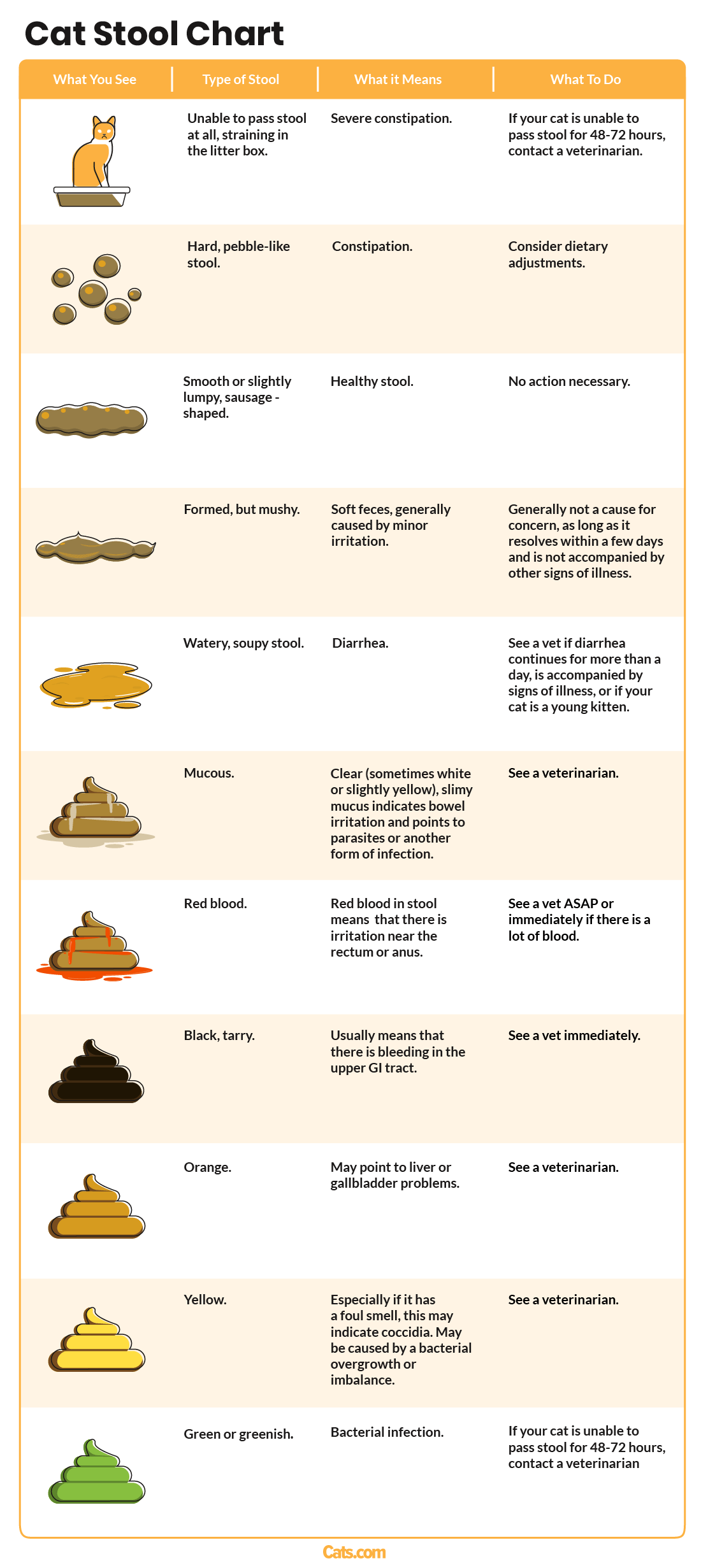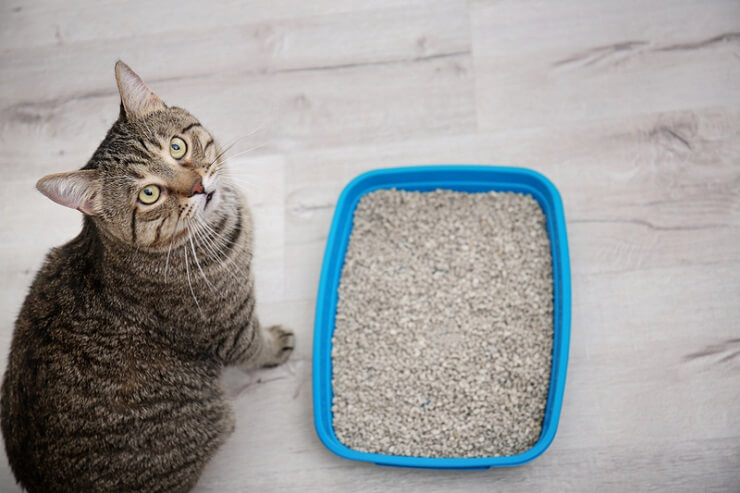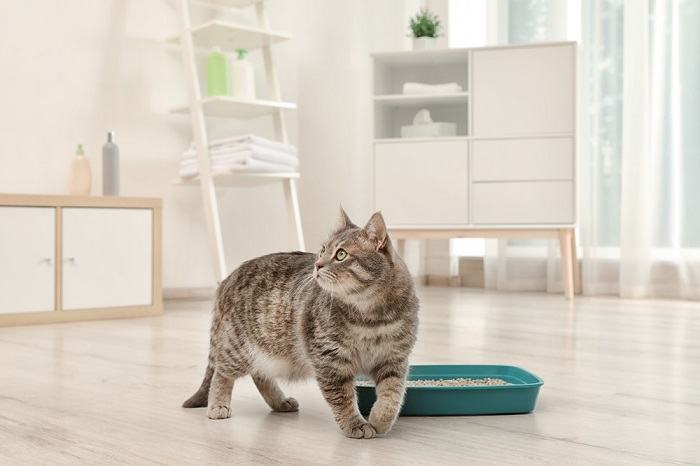
Why use a cat stool chart? Because your cat’s feces is one of the biggest indicators of their health.
Put simply, a healthy cat should have healthy stools. While there are many specific health issues that can cause signs from constipation to diarrhea, it’s a simple rule that normal feces (or stools) are a good sign that your cat is thriving.
When you visit your veterinarian, it’s likely that you will be asked to describe your cat’s stools, as part of the general gathering of information about your cat’s health, and in particular, information about the gastrointestinal tract.
Cat Stool Chart
The cat stool chart infographic below is a simple, clear way of giving you information to help you decode the appearance of your cat’s feces.
The image on the left-hand column is the starting point: choose whichever one most closely resembles your cat’s stool. The second column is a written description of the appearance of the stool, and the third column is an explanation of the most likely reason for that appearance. Finally, the fourth column gives you advice on what action you need to take as a consequence of that particular stool appearance.

Breakdown Of Cat Stool Health Indicators Based On Color And Consistency

Fecal abnormalities may point to a wide variety of issues affecting the digestive tract and beyond.
It can be difficult to observe your cat’s bowel movements if they are outdoor pets, but if they use a litter box, you should take advantage of the daily task of scooping their poop to observe it in detail.
A normal cat stool should be brown or dark brown in color, with a reasonably firm consistency. The idea is that it should be formed, but should not be too hard.
There should be no sign of mucus or blood. It is possible to carry out “fecal scoring” based on a cat’s poop look, but there may be no need to get into such a detailed, formal way of carrying out an assessment.
Abnormalities that should be noted include:
- Extraneous matter, like hairballs.
Soft feces (formed, but mushy) can be caused simply by a sudden change of diet (e.g. from Purina to a different brand). Other possible causes include mild or early cases of diseases listed below that can cause more significant diarrhea. - Loose feces (diarrhea) can be caused by a number of factors, including intestinal irritation (e.g. by intestinal parasites such as tapeworm), bacterial infections, liver disease, kidney disease, or inflammatory bowel disease (IBD), food allergy, and food intolerances. Some health problems, like hyperthyroidism, can cause this type of diarrhea as well as a range of other signs of illness.
Broadly, There Are Two Sub-types Of Cat Diarrhea

First, small intestinal diarrhea tends to be larger pools of loose feces, passed less frequently. If blood is present, it may be darker, sometimes described as “tarry” (because it has been digested as it has passed through the digestive tract).
Second, large intestinal diarrhea (e.g. associated with colitis) tends to be smaller amounts of loose feces, passed more frequently, often with a sense of urgency. Streaks of mucus and fresh blood may be seen.
Read More: Best Cat Food for Diarrhea
Hard stool is the opposite of diarrhea, and this can indicate a range of other possible problems, You should also note the process of defecation: if your cat is straining when pooping (so-called “fecal tenesmus”) this can indicate constipation (e.g. megacolon or a blockage of some kind) or alternatively, this can be caused by irritation of the lower bowel.
You may notice your cat over-grooming around the same time as passing feces: this can suggest discomfort or abdominal pain.
Frequently Asked Questions:
What does a normal cat poop look like?
As mentioned above, a healthy cat poop should be brown or deep brown in color (not yellow, not pale, not black), and it should be well formed, like an uncooked sausage. There should be no blood, and no streaks of mucus.
How can I tell if my cat's poop is healthy?
You should monitor your cat’s poops in the litter box every day, so that you are familiar with the normal appearance and consistency of your cat’s poo. The answer to “what’s the scoop about my cat’s poop” is a useful indicator of your cat’s overall health.
How much should a cat poop in one day?
There are no absolute rules about frequency and quantities of cat poops, but most cats in good general health pass stools once or twice daily, with lengths of four to six inches (10 -15cm) on each occasion.
Why is my cat's poop jelly-like with blood?
This is a sign that your cat's digestive system is inflamed for some reason: the jelly-like appearance means that the wall of the intestine is producing too much mucus, while the blood indicates that blood is oozing from the intestinal wall. These are both events that occur following inflammation of the wall of the intestine. A cat with this type of poop needs to be taken to the veterinarian as soon as possible.
Why is my cat's poop mucus?
If there is copious mucus in your cat's poop, this indicates that the wall of the wall of the intestine is inflamed, causing increased production of mucus. There are many possible causes, including parasites and inflammatory bowel disease, and you do need to take your cat to your local veterinarian for this to be investigated further.
Why is my cat's poop yellow?
This is an abnormal finding, and it may indicate a number of different conditions, including coccidiosis, or a bacterial infection or imbalance. You should take your cat to your local veterinarian for this to be investigated further.








Did not address my cat’s feces. My cats feces are loose, shapeless, like a cooking batter. (cake, pancake). At times the feces changes to what meets the diarrhera description.
Well, it sounds like your cat’s feces are somewhere between “formed and mushy” and “watery soupy stool”. And so the advice would fall between the two of those, as in “not a concern if resolves within a few days”. In your cat’s case, it has clearly gone on for more than a few days, so that means that you should take them to your veterinarian, along with a stool sample. There is a long list of possible causes, and it’s best if your veterinarian guides you through the investigative process so that your cat’s issue is solved as soon as possible.
My cats feces smells horrible. Buy it looks normal.
My cat has been pooping maybe one to two times a day but the quantity is small. I would say about an inch and a half to 2 inches at most in length and width of a nickel. Color and consistency are fine, but I’m concerned that the amount of which he goes is too small and he might be constipated. Is this an okay amount?
This amount of poop is just fine. When cats are fed high quality, highly digestible food, most of the nutrients are absorbed and there is very little waste left. So I would just be grateful for the less cleaning up that’s needed, and don’t worry as long as he is not straining or showing other signs of discomfort.
My adopted calico mix cat is almost three years old and full of energy. But her poop is always like marbles. I feed her Fancy Feast which is very soft veggie mix and Purina dry food for indoor cats. I see her drinking from two bowls a room apart in a snpmall apartment.m she needs play time daily which I give her . Should I worry about her?
If she is very well in general, and the only issue is marble-like poo, and she is able to pass these poops with no problem, then I do not think this is something to worry about. There is always some element of individual variation, and as long as cats remain generally well, with no serious straining to pass poops, and no blood in the poops, then simple continued monitoring is enough.
Just had cat spayed at clinic she is 6 nmos old, thrown away. thin. She was doing fine til clinic, did not take our food, did not give anti nausea Vomiing happenin, no poop. She is barely eating but drinking. Back to clinic now the anti nausea meds and no directions or meds for constipation. After 15 more hours it is now 3 days a Deer size hard poop came out. 12 hours later another deer poop came out I 1/2 in hard but had enogu moisture to attract litter. I up the food, put wanter in, that was Fri, one poop like dear bout half inch Sat. It is Sunday I had no urine???? I had another half inch hard poop she seemed uncomfortable. I use wasm water, more meals, table spoon added woter….Sunday night I get urine. I am walking her around to get her active, cage is not active.
Today I added a half teaspoon of organic natural pumpkin 1/2 teapoon in daytime….it is over 12 hours no poop she is eating almost a can a day, and about 1/8th of c of dry. This is after spay….she is watched when out… but she needs excercise, trying to keep her down, making bridges, no steps. What is wrong I am at wits end. she was thin, was great eater. I brought our food our water, they refused but kept her three days. I do not want to see this kitten decline, she is lovely ha bad scars from others….I believe she needs a chance to get back to her schedule but I try six meals, fresh food, fresh water, good food….nothng
Hello Michele, apologies for the late reply! Sometimes, the medications used during a spay surgery can cause constipation, but that shouldn’t last for more than 2 days. Not being able to urinate is also a very concerning sign. How is this kitten doing now? I’m afraid this is a very complicated question that requires the advice of a vet who’s able to inspect and test your kitten. Our community forum may be able to help. Hope you’re able to get this figured out!
Hi Lynn – there is such a wide variation of possible stool colour and consistency changes that it is impossible to include them all in an article like this, and the type of striping that you suggest, while interesting to observe, does not tally specifically with any particular issue that I am aware off. Sorry not to be more helpful. Pete
p.s. Two symptoms my 2 presumed FIP cats developed soon after the feral kitten was living in the extra bedroom were 1) a nasty upper respiratory infection, which I treated successfully with colloidal silver, and 2) stool that was the normal consistency, color and smell, EXCEPT that it had longitudinal “stripes” of lighter brown stool (NOT mucous – it’s the same solid consistency as the darker stool) running through it. I’ve been searching in vain for a post about stool of that color, but have never seen any mention of that particular poop appearance – another reason I think they could both have developed FIP…because if it’s really rare for cats to be exposed to that virus, let alone become actually sick and then of course die from it, it makes sense no one else would be talking about it! Have you ever seen cat stool with that appearance?
That’s an incredibly interesting question, Lynn. Unfortunately, I can’t answer that question for you as I’m not a vet, but you may be able to get some insight from the veterinary moderators in the All About Cats community forum.
I just recently rescued a male cat that was dumped. He has been coughing and sneezing with mucus coming out of his nose. He is eating regularly and going to the bathroom regularly. I don’t have the money to take him to the vet at the moment. Is there anything i can do at home to help cure it. I have been using a wet cotton ball to wipe his nose after he sneezes. Please help me help this poor cat. I guess Hes prolyl 1 or 2 years old. Also, how can i tell how old he is for sure. Thank you for any help. First time owner of a cat.
Hello Keli, thanks for the comment. This is a big question. So, first off, coughing and sneezing with mucus can be a symptom of multiple conditions, but the best guess is probably a URI or upper respiratory infection. This vet-approved guide shares some more details on the condition and how it affects cats. Kitten Lady also offers some nice tips for caring for a cat with a URI. Regarding the age of your cat, it is difficult to get an exact age, but you can roughly age an adult cat based on the condition of their teeth, coat, overall physical condition, and behavior. This article goes in-depth on determining how old a cat is. Hope this helps at least a little bit. Thank you for stopping by!
My male neutered cat (was a stray so poss 8/9 yrs old) has started peeing small amounts on bathroom floor (litter tray in same room) and also poops small very hard dark lumps in same room. He eats and drinks well. Would appreciate your comments.
Hi Gillian, it’s hard to say if the two issues are related, but I would recommend taking your cat to see a veterinarian for a proper examination and assessment. It’s possible that he’s avoiding the litter box due to stress or discomfort associated with constipation, or he may have developed an aversion to the litter box for another reason. In any case, a wholesome high-moisture diet can help to support both urinary and digestive health, so I’d recommend looking into dietary improvements as well as an assessment from a veterinarian.
Very helpful article there. I recently changed my cat’s dry food brand since then she’s been having loose stool 2 to 3 times a day with foul smell and after some time I noticed blood in her stool although she is fine overall. She is drinking enough water plus she is unneutered 1 year old and never got to mate. Also, she likes to eat in small quantities after some time it looks like she is unable to eat at a time. I feed her dry food morning and evening, homemade for lunch.
Thanks for info. My 15 yr old has constipation problem…have started feeding him only wet food with little extra water but he does drink water from water bowl. Suggestions to help him…..????
There are a number of possible answers, depending on the precise cause of his constipation. Make sure that your veterinarian has checked him recently: issues like liver disease, kidney disease and others can present with constipation sometimes. You should then discuss the specific issue of constipation with your veterinarian and depending on the details, they will be able to offer specific answers e.g. fibre for the diet, stool softeners etc. The right answer is different for each different cat.
So glad to have found your site! Just FYI regarding the post on constipation: A wonderful vet of mine who incorporated naturopathic solutions into his work (after discovering intravenous ozone and other “unproven” – and therefore IGNORED yet VERY EFFECTIVE – therapies, that staved off his own Myasthenia Gravis and extended his life for a here-to-for impossible 25+ years!) solved my Maine Coon mix cat’s chronic (and on several earlier occasions, acute and life-threatening) IBD/constipation issues by prescribing a wonderful human product by Aet\robic Life called Mag07 Powder. This amazing product softened his stool so it literally COULDN’T harden, by drawing additional moisture into the bowel. It without question added 17 wonderful, healthy years to the life of my cat, who eventually passed at 18 – from a very long row of “poop balls” in his colon, after even the Mag07 wasn’t enough. I FERVENTLY wish there were a similar life-saving treatment for my current cat, who I am now certain has FIP, and whose companion suddenly had to be euthanized after exhibiting the same symptom (sudden onset rapid and extreme weight loss), worsening over 5-7 months. I am now convinced they both caught the FIP from of a 3 month old “feral” kitten I rescued back in December 2021, that I kept in a separate room but didn’t keep adequately “isolated” (because who would have thought a kitten could kill off 2 adult cats, just by my kissing and hugging them all?). The kitten shows no symptoms whatsoever, but she is literally the only thing that changed in my home since I adopted the 2 adults from a shelter almost years ago.